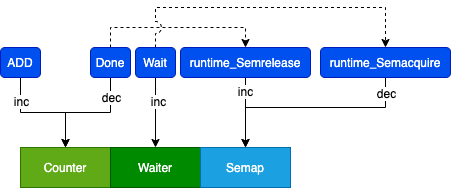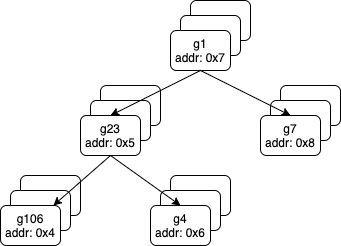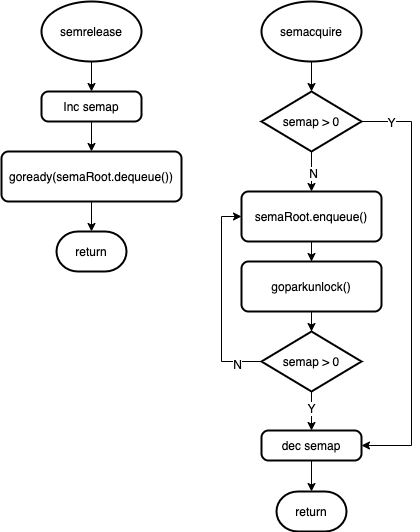golang sync.WaitGroup 底层实现
15 February 2020
数据结构
// A WaitGroup waits for a collection of goroutines to finish.
// The main goroutine calls Add to set the number of
// goroutines to wait for. Then each of the goroutines
// runs and calls Done when finished. At the same time,
// Wait can be used to block until all goroutines have finished.
//
// A WaitGroup must not be copied after first use.
type WaitGroup struct {
noCopy noCopy
// 64-bit value: high 32 bits are counter, low 32 bits are waiter count.
// 64-bit atomic operations require 64-bit alignment, but 32-bit
// compilers do not ensure it. So we allocate 12 bytes and then use
// the aligned 8 bytes in them as state, and the other 4 as storage
// for the sema.
state1 [3]uint32
}
- noCopy:用于 go vet 检查 sync.WaitGroup 类型变量是否采用了值传递的方式
- 如果采用了值传递,go vet 检查会抛出错误:call of foo copies lock value: sync.WaitGroup contains sync.noCopy
- 因为如果采用值传递,那么 state1 就会被复制一份,而对应的信号量并不会跟着复制,所以值传递后复制出来的是一个不可用的 WaitGroup
- state1:12字节内存
- 4字节用于 wg.ADD 和 wg.Done 的计数
- 4字节用于 wg.Wait 的计数
- 4字节用于信号量的唤醒和等待

WaitGroup.state()
根据内存地址计算12字节中,哪8字节用于 wg 的计数,哪4字节用于信号量的唤醒和等待。
// state returns pointers to the state and sema fields stored within wg.state1.
func (wg *WaitGroup) state() (statep *uint64, semap *uint32) {
// 判断地址是否8字节对齐
if uintptr(unsafe.Pointer(&wg.state1))%8 == 0 {
return (*uint64)(unsafe.Pointer(&wg.state1)), &wg.state1[2]
} else {
return (*uint64)(unsafe.Pointer(&wg.state1[1])), &wg.state1[0]
}
}
WaitGroup.Add() 和 WaitGroup.Done()
// Done decrements the WaitGroup counter by one.
func (wg *WaitGroup) Done() {
wg.Add(-1)
}
WaitGroup.Done() 实际上是调用的 WaitGroup.Add(),来分析下其源码:
func (wg *WaitGroup) Add(delta int) {
// statep:用于 wg 计数
// semap:用于信号量唤醒和等待
statep, semap := wg.state()
if race.Enabled {
_ = *statep // trigger nil deref early
if delta < 0 {
// Synchronize decrements with Wait.
race.ReleaseMerge(unsafe.Pointer(wg))
}
race.Disable()
defer race.Enable()
}
// delta 是 int 类型,强制转换为 uint64 类型做加法操作,相当于补码运算
state := atomic.AddUint64(statep, uint64(delta)<<32)
// 高 32bit 用于 ADD 和 Done
v := int32(state >> 32)
// 低 32bit 用于 Wait,统计等待的 goroutine 数量
w := uint32(state)
if race.Enabled && delta > 0 && v == int32(delta) {
// The first increment must be synchronized with Wait.
// Need to model this as a read, because there can be
// several concurrent wg.counter transitions from 0.
race.Read(unsafe.Pointer(semap))
}
// v 不应该小于 0,小于 0 说明使用不当
if v < 0 {
panic("sync: negative WaitGroup counter")
}
// w != 0 说明已经有 Wait 调用,并且当时观察到 v > 0
// 如果出现 delta > 0,并且 v == int32(delta),说明发生过 Done 调用,且该 Done 调用观察到 v == 0,会唤醒所有等待的 goroutine,然而实际上 v > 0,这与 WaitGroup 要实现的功能相悖。
// 所以确保 Wait 和 Add 不进行并发调用的话,Wait 的语意才能得到保证
if w != 0 && delta > 0 && v == int32(delta) {
panic("sync: WaitGroup misuse: Add called concurrently with Wait")
}
if v > 0 || w == 0 {
return
}
// v == 0 && w > 0 需要唤醒等待的 goroutine
// This goroutine has set counter to 0 when waiters > 0.
// Now there can't be concurrent mutations of state:
// - Adds must not happen concurrently with Wait,
// - Wait does not increment waiters if it sees counter == 0.
// Still do a cheap sanity check to detect WaitGroup misuse.
// 再检测一次是否出现了 Add 和 Wait 并发调用了
if *statep != state {
panic("sync: WaitGroup misuse: Add called concurrently with Wait")
}
// 重置等待计数为 0
// Reset waiters count to 0.
*statep = 0
// 唤醒所有等待的 goroutine
for ; w != 0; w-- {
runtime_Semrelease(semap, false, 0)
}
}
WaitGroup.Wait()
// 阻塞等待,直到 WaitGroup 的计数器为 0
// Wait blocks until the WaitGroup counter is zero.
func (wg *WaitGroup) Wait() {
statep, semap := wg.state()
if race.Enabled {
_ = *statep // trigger nil deref early
race.Disable()
}
for {
state := atomic.LoadUint64(statep)
v := int32(state >> 32)
w := uint32(state)
// 计数器为 0,不需要等待
if v == 0 {
// Counter is 0, no need to wait.
if race.Enabled {
race.Enable()
race.Acquire(unsafe.Pointer(wg))
}
return
}
// Increment waiters count.
// CAS 操作,递增等待计数器
if atomic.CompareAndSwapUint64(statep, state, state+1) {
if race.Enabled && w == 0 {
// Wait must be synchronized with the first Add.
// Need to model this is as a write to race with the read in Add.
// As a consequence, can do the write only for the first waiter,
// otherwise concurrent Waits will race with each other.
race.Write(unsafe.Pointer(semap))
}
// 在 semap 上进行等待
runtime_Semacquire(semap)
// 被唤醒后计数器应该为 0
if *statep != 0 {
panic("sync: WaitGroup is reused before previous Wait has returned")
}
if race.Enabled {
race.Enable()
race.Acquire(unsafe.Pointer(wg))
}
return
}
}
}
runtime_Semrelease 和 runtime_Semacquire
信号量唤醒和等待的实现,代码在 src/runtime/sema.go。semap 会被用作信号量计数器,也会被用来索引 semtable,获取 semaRoot。
semaRoot 是平衡二叉树的实现,存储着在不同地址上进行等待的 goroutine 节点,同一地址上进行等待的 goroutine 会以双向链表的形式组织起来,如下图:

在 runtime_Semacquire 中,如果能递减 semap,则直接返回,否则调用 semaRoot.queue 方法入队,然后调用 goparkunlock 挂起,等待被唤醒。
在 runtime_Semrelease 中,递增 semap,调用 semaRoot.dequeue 方法出队,然后调用 goready 唤醒对应的 goroutine。
